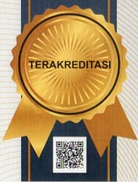Peran Penting Model Pelatihan Maximizing 15-Minutes (M1ME) Pada Departemen Host Service di Alila Seminyak: Perspektif Manajer
Abstract
Tujuan dari penelitian ini adalah untuk menganalisis bagaimana implementasi dari Maximizing 15-Minutes (M1ME) Training pada Host Service Department Alila Seminyak dari Perspektif Manager. Data penelitian ini dikumpulkan dari kuesioner, wawancara, dan studi dokumentasi. Data yang terkumpul dari kuesioner kemudian dianalisis menggunakan SPSS versi 23. Hasilnya menunjukkan bahwa Pelatihan Maximizing 15-Minutes (M1ME) berpengaruh positif dan signifikan terhadap persepsi kualitas, persepsi biaya, persepsi volume/produksi, persepsi efisiensi, persepsi kepatuhan, keamanan yang dirasakan, kepuasan karyawan yang dirasakan, kepuasan pelanggan yang dirasakan, respon pelanggan yang dirasakan dan respon pasar di Alila Seminyak.
Keywords
Full Text:
PDFReferences
Alshuwairekh, K. N. (2016). The effectiveness of the training programs on employees performance: an empirical study at private sector companies in saudi arabia. International Journal of Business and Management Review, 4(9), 1–23.
Arthur, W. J., Bennett, W. J., Edens, P. S., & Bell, S. T. (2003). Effectiveness of training in organizations: a meta-analysis of design and evaluation features. The Journal of Applied Psychology, 88(2), 234–245. https://doi.org/10.1037/0021-9010.88.2.234
Bartel, A. P. (1994). Productivity Gains from the Implementation of Employee Training Programs. Industrial Relations: A Journal of Economy and Society, 33(4), 411–425. https://doi.org/https://doi.org/10.1111/j.1468-232X.1994.tb00349.x
Benabou, C. (2006). Assessing the impact of training programs on the bottom line. National Productivity Review, 15, 91–99. https://doi.org/10.1002/npr.4040150310
Blaiwes, A. S., Puig, J. A., & Regan, J. J. (1973). Transfer of Training and the Measurement of Training Effectiveness. Human Factors, 15(6), 523–533. https://doi.org/10.1177/001872087301500604
Booth, A. L. (1991). Job-Related Formal Training: Who Receives It and What Is It Worth? Oxford Bulletin of Economics and Statistics, 53(3), 281–294.
Gorbatov, S., & Lane, A. (2018). Is hr missing the point on performance feedback? Retrieved April 29, 2022, from https://sloanreview.mit.edu/article/is-hr-missing-the-point-on-performance-feedback/
Hussain, S., Rizwan, M., Nawaz, M., & Hameed, W. (2013). Impact of Effective Training Program, Job Satisfaction and Reward Management System on the Employee Motivation with mediating role of Employee Commitment. Journal of Public Administration and Governance, 3, 278. https://doi.org/10.5296/jpag.v3i3.6222
Jassim, R. (1998). Competitive Advantage Through the Employees.
Kirkpatrick, J. D., & Kirkpatrick, W. K. (2016). Kirkpatrick’s Four Levels of Training Evaluation (1st ed.). Virginia, USA: ATD Press.
Kunche, A., Puli, R. K., Guniganti, S., & Puli, D. (2011). Analysis and evaluation of training effectiveness.
Nawaz, N., & Prathibha. (2013). Role of Talent Management Importance in any orgaization.
Onyango, J. W., & Wanyoike, D. (2014). The effects of training on employee performance A survey of health workers in Siaya. European Journal of Material Sciences, 1(1), 11–15.
Ostroff, C. (1991). Training effectiveness measures and scoring schemes: A comparison. Personnel Psychology, 44(2), 353–374. https://doi.org/10.1111/j.1744-6570.1991.tb00963.x
Phillips, J. J. (2011). Handbook of Training Evaluatiion and Measurement Methods (3rd editio). New York: Routledge.
Poulet, R. (1986). Training Process Effectiveness. Industrial and Commercial Training, 18, 10–13.
Punia, B. K., & Kant, S. (2013). A review of factors affecting training effectiveness vis-à-vis managerial implications and future research directions. International Journal of Advanced Research in Management and Social Sciences, ., 02, 151–164.
Raguž, I. V., Zekan, S. B., & Peronja, I. (2017). Knowledge as a source of competitive advantage in knowledge based company. Management and Organisation, 533–544.
Rai, N., & Thapa, B. (2015). A study on purposive sampling method in research. Retrieved April 30, 2022, from https://www.academia.edu/28087388/A_STUDY_ON_PURPOSIVE_SAMPLING_METHOD_IN_RESEARCH
Rathore, S. S., & Rathone, P. (2015). Talent management practices in luxury and low budget hotels: conceptual view point. International Research Journal of Management Science & Technology, 6(7), 122–130.
Sitzmann, T., & Weinhardt, J. M. (2015). Training Engagement Theory: A Multilevel Perspective on the Effectiveness of Work-Related Training. Journal of Management, 44(2), 732–756. https://doi.org/10.1177/0149206315574596
Spitzer, D. R. (1984). Why Training Fails. Performance and Instruction Journal, 6–10.
Spitzer, D. R. (2005). Learning Effectiveness Measurement: A New Approach for Measuring and Managing Learning to Achieve Business Results. Advances in Developing Human Resources, 7(1), 55–70. https://doi.org/10.1177/1523422304272167
Swanson, R. A., & Sleezer, C. M. (1987). Training Effectiveness Evaluation. Journal of European Industrial Training, 11(4), 7–16. https://doi.org/10.1108/eb002227
Zahra, S., Iram, A., & Naeem, H. (2014). Employee Training and Its Effect on Employees Job Motivation and Commitment: Developing and Proposing a Conceptual Model. IOSR Journal of Business and Management, 16, 60–68.
DOI: https://doi.org/10.32487/jshp.v6i2.1453
Refbacks
- There are currently no refbacks.
JSHP: Jurnal Sosial Humaniora dan Pendidikan
is licensed under a Creative Commons Attribution-ShareAlike 4.0 International License (CC BY-SA 4.0)




